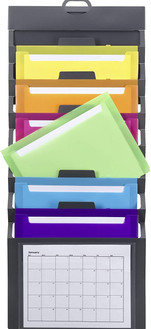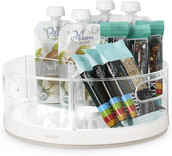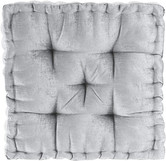Easy, Last-Minute, Home Learning Set-Up Guide
- Laura Weiler
- Sep 3, 2020
- 6 min read
Uh oh. School is starting soon (or has started). And you need it to be better than the spring, when everything was done on the fly and people were working all over the place. But maybe you haven't really set up that home workspace yet. (Who wanted to think about their home learning set-up for fall over the summer? Not me!)
Take a deep breath...and...relax. Your kids don't need a deluxe homeschool set-up and you don't have to devote a weekend to creating a home classroom. These ideas can be set up with things already in your home or ordered in minutes and delivered in days.
A side note: back in March I shared suggestions for setting up temporary learn-from-home spaces, and most of those tips are still applicable. You can check it out here.
Scenario 1: Your middle or high schooler has a desk in their room. It just needs to work a little harder.
Managing multiple subjects and teachers is easier when papers and materials are sorted. Have wall space? Or the back of a bedroom or closet door? Use a cascading wall organizer (compact version) or cascading wall pockets to sort and contain class materials without taking up valuable desk space. If wall space isn't an option, a desktop file box keeps things contained and there are plenty of styles (metal, acrylic) to fit any space.
Magazine holders are fantastic for books and papers. They kept things neat and it's easy to see and find everything—plus vertical storage maximizes space. Cardboard options are inexpensive, but acrylic holds up best over time and there are so many uses for these that it's worth getting something that will last. These are my favorites from Amazon, but you can also find them at Target, or any office supply store.
Make sure they have good lighting. Natural light is best for productivity, but if windows don't let in enough you might want a task lamp. This is really a matter of taste and room style, but there are task lights with USB ports, ones that mimic natural light, options that integrate desktop supply storage.
Set some ground rules—more likely to be effective if you work together to develop them. Are phones allowed during school hours? What about music? TV? Do they need to leave their rooms for lunch?
Scenario 2: Your kid just wants to work on the couch.
Ok, it may not provide optimal ergonomics, but sometimes you have to pick your battles. A lap desk can make all the difference when you're not sitting at a desk. There are all kinds of options, with built-in tablet and phone slots meant for primarily for devices, or simple and basic ones meant chiefly for writing, or somewhere in between.
You also need a portable solution for supplies like pens and markers. I like this caddy because it's one piece, has a handle, both small and large compartments, and is easily cleaned. (It also makes a great holder for cutlery and napkins for outdoor dining, so you might want a two-pack.) There's also a larger version.
Scenario 3: The kitchen table is your child's desk...but you also need to eat dinner there.
This scenario calls for portability, and I'd argue that a metal three-tier cart is your best friend. Store everything your kid needs in it, and roll it over (or away) as needed. Ours came from Ikea several years ago, but they can be found so many places: Michaels, the Container Store, Amazon. You can stay basic or go completely tricked out with add-ons. When the kids are back in school full-time, the cart can be repurposed as a bar cart, a craft cart, a place for in-progress projects...so many options. You will want to subdivide the space with magazine files and small containers for supplies to keep it from becoming messy (see more details here).
Scenario 4: You have multiple kids who all need to work at the dining room table and be on class calls simultaneously.
Maybe in an ideal world each kid would have their own space in different rooms, but if that doesn't work in your house don't worry—one table can work for multiple kids.
Headphones are key, and there's no shortage of options, from bluetooth to LED-lit to comfortable and colorful. Over-the-ear will do a better job of blocking out surrounding noises, and it's worth thinking about whether or not a built-in microphone is needed.
If seeing each other is a distraction for your kids, there's a really easy way to divide table space: trifold presentation boards. They're inexpensive, easy to fold up and move before dinner, and you can write on them if it's helpful (log in details, reminders, schedules, etc.) or keep them completely blank and just be ready for the next time there's a school science fair or big presentation (because those days will return eventually). White is the most versatile but they also come in colors. If you want something shorter, try privacy boards.
If you're not dividing the space with presentation boards, a lazy susan lets everyone reach the supplies. This 11" one is my favorite; great for snacks, under the kitchen sink supplies, you name it. When the kids are back in school, you can repurpose this in so many places around your house. Or give each kid their own mini art caddy.
Scenario 5: Your kids want to work in approximately 6 different places in your house, from their bed to the couch to the hammock in the back yard.
Versatility and movability are the key things to keep in mind here. Portable supply caddies (or even a sewing bag with lots of pockets), a 3-tier cart, and lap desks (as mentioned above) are all good solutions. If your kids like to work on the floor, floor pillows make it a lot more comfortable and are also great for watching TV and slumber parties (once things are back to normal). And easy-to-move side table or bedside table is another option for a versatile work surface.
And a few things that apply to all scenarios:
Kitchen and dining room chairs were designed for relatively short periods of sitting—not 4 or 6 hours in front of a computer. They don't have lower back support, or adjust to the ideal height for writing and computer work, and may or may not be cushioned. Adding a cushion or lower back support might make a world of difference in terms of comfort. (As with most things, you can invest a lot or a little here.) And if you have younger/shorter kids, you may want to put a footrest under their chair. There's a reason elementary school furniture is smaller—so kids' feet rest on the floor instead of dangling. If you find that your kids are squirming and restless, they might legitimately be physically uncomfortable.
Everybody needs to move—humans are just not meant to sit for hours at a time. In a high school or middle school setting, kids naturally get up and move as they switch classes. Movement is built into elementary school classrooms because kids need it. Make sure it happens at home too, by setting a timer. Older kids can use a watch or phone; younger kids can use a basic kitchen timer or a visual countdown timer.
Don't underestimate the value of fun supplies. Think about a classroom—teachers decorate for a reason. If a unicorn tape dispenser, pretty calendar, SuperMan sticky notes, or dinosaur bookends makes it just a little more fun for your kids to tackle school at home, hey, every little bit helps.
Minimize distractions when and where you can. Research has shown that visual distractions make it harder for kids to retain information. Toys, extra cords, a cluttered bulletin board, lots of pictures and decor—do what you can to minimize what's in their field of vision. If the rule is no phone at school, keep that rule in place for school at home, too.
Have an official end to the school day that involves putting away all materials and getting the space ready for the next activity, whether it's eating dinner or watching TV. Kids do this at school—moving desk chairs, putting away supplies, packing up to go home—and they can do it at home too. This is especially important if their school space is really a shared space like a living room or kitchen table.
And last but not least, give yourself grace—kids are resilient and adaptable and they're less likely to freak out if they don't see you freak out (at least in front of them; no judgement if you occasionally hide in a closet and yell, or pour a glass of wine the minute they're in bed).
Whatever this year looks like, we will all make it through. And as with anything, it will be easier if you organize when and where you can!
This post contains affiliate links which support this blog at no increased cost to you.

































































Comments